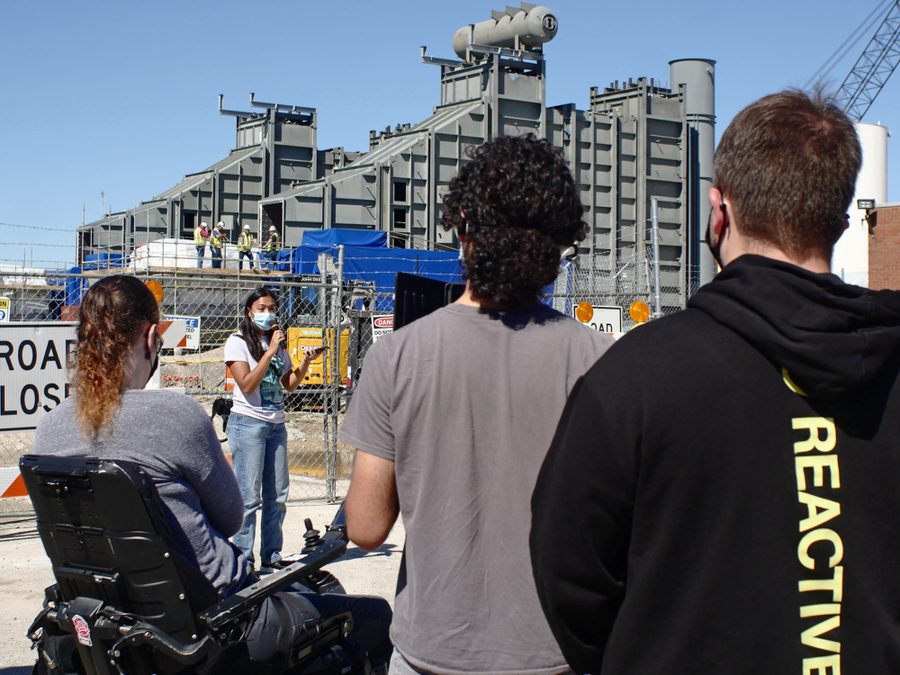An Ohio College Privatized Its Energy and Built a Gas Plant on Campus, Outraging Students
OSU announced in 2008 its goal to go carbon neutral by 2050. Now, however, the university is pursuing the construction of a new, gas-powered energy plant despite student protests holding them accountable.
Taylor Dorrell

About 40 students and activists march to the office of Ohio State University President Kristina Johnson on Sept. 24, 2021, demanding a halt to the construction of a $278 million gas power plant. “We will not give up,” Chandler Rupert, leader of the campus chapter of Students for a Democratic Society, blasts over a megaphone.
Columbus is Ohio’s capital and the fastest-growing city in the Midwest. And its climate action plan is aggressive. In 2020, the mayor announced a goal to go carbon neutral by 2050, and voters passed a Sierra Club-backed plan for 100% renewable energy by 2024. Some of Columbus’ large companies, which are exempt from these requirements, have opted into the city’s 100% renewables pilot.
Ohio State, a public university with more than 61,000 students, sits just north of downtown. It requires its own energy infrastructure to supplement the city’s, and back in 2008 announced its own goal to go carbon neutral by 2050. At the same time, the university has pursued construction of new, gas-powered energy.
In 2017, in exchange for $1 billion (plus a gift of $150 million to “support academic priorities”), Ohio State sold its energy infrastructure to two French companies: the investment firm Axium Infrastructure and the gas and electricity supplier ENGIE. Axium and ENGIE then formed a joint venture, Ohio State Energy Partners (OSEP), to operate the university’s heating, cooling and power, with plans to build the gas plant. OSEP’s board of directors is run by ENGIE and Axium higher-ups.
In a press release, Ohio State said the privatization effort pointed to “sustainability and high-quality, efficient operations.” It will pay OSEP at least $54 million a year for its services.
The Sierra Club sought to block the new gas plant, claiming it conflicted with decarbonization plans. At a June 2020 approval hearing with the Ohio Power Siting Board, the chair of the Ohio Public Utilities Commission, Sam Randazzo, grilled the Sierra Club’s Cathy Cowan Becker about whether the city could really transition to 100% renewable energy. He later resigned from the commission in November 2020 after his home was searched by the FBI; he had allegedly accepted $4 million in bribes from First-Energy, a company that paid off Ohio politicians in 2019 to bail out their plants and gut renewable energy standards.
Sierra Club lawyers cited a 2021 Ohio law requiring the state to only approve projects that represent “the minimum adverse environmental impact.” The university’s counterargument was that the law shouldn’t apply, because wind and solar aren’t “practicable” at scale.
The power siting board approved the plan in September 2020, sparking protest. “They claim one thing [about investing in renewables] and then they do the other,” environmental science student Katy Jobe said at the Sept. 24, 2021, event.
At another protest, in May 2021, a dozen activists rallied outside of the university president’s house. According to protesters, Johnson’s response was to instruct students to decrease their own carbon footprints and announce she was buying an electric car. She also called the campus police.
Many of the progressive student groups that oppose the plant are also concerned about fracking. In 2018, an XTO Energy/ExxonMobil natural gas well blew out in eastern Ohio and leaked more methane in 20 days than most European countries do in a year. Methane also has more than 80 times the warming power of carbon dioxide. And fracking has made earthquakes more common in Ohio, with one of the United States’ biggest fracking-caused earthquakes shaking Ohio in March 2014.
“Being repeatedly pushed aside is not helping the university’s case on this,” says Vicky Abou- Ghalioum of GradRoots, a coalition of grad students in the School of Environment & Natural Resources. Abou-Ghalioum says that, in response to the protests, Johnson invited her and other activists to sit on a sustainability task force — which never met.
Other universities are having similar experiences, with at least 60 universities owning coal-powered plants, many of which are being phased out. Iowa State University, Michigan State University and Virginia Tech have switched (or plan to) from coal to natural gas, rather than to renewables. Duke University tried, but students and community members fought the plan, which has been delayed indefinitely.
Anagha Velamakanni, campus co-chair of the Young Democratic Socialists of America, emphasizes that the fight doesn’t only concern current students. “After I graduate, guess what’s still going to be there?” Velamakanni says. “The plant,” due to be completed in December 2021.
Still, Velamakanni is determined: “We’re not going to give up, because this is going to harm the environment and harm the people.”
Taylor Dorrell is a journalist based in Columbus, Ohio, who writes on labor, politics, culture and the environment.





